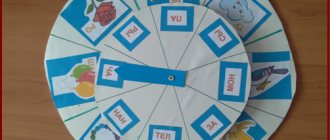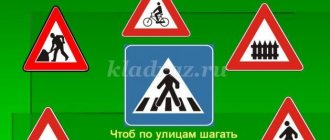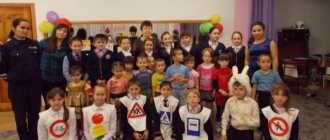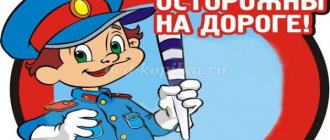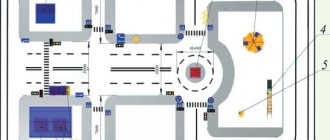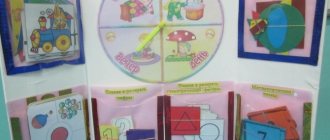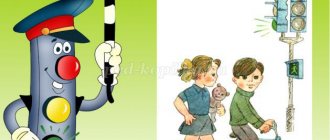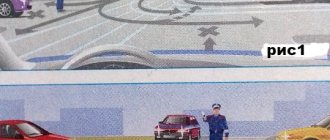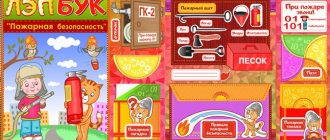Plan for traffic rules in the senior group for 2. For kindergarten teachers, school teachers and educators Natalya Asanova Plan for traffic rules in the senior group for 2. Joint activities of the teacher with children.
Independent activity of children. Working with parents. September. Lesson “I am a pedestrian - I am a passenger.” Target walk to the crosswalk. Reading works: G. Georgiev “Traffic Light”, S. Mikhalkov “Uncle Styopa - Policeman”. Looking at illustrations.
Unusual author's folder-moving according to traffic rules
Larisa Bukina
Unusual author's folder-moving according to traffic rules
One of the important areas in the work of a preschool teacher is to familiarize children with the rules of the road. We also involve parents in this work, who are direct examples for their children, acting as road users.
Mobile folders , in which you can place any information on issues of interest, serve us as direct assistants in this matter.
I think that a mobile folder should contain not only useful information, but also be an object of decoration for the reception area, unusual and eye-catching.
And I made a folder that I now want to bring to your attention.
For this folder I needed : cardboard (the size of the cardboard sheet should be larger than A4)
; fleece fabric of different colors, “Moment” glue - transparent gel. I love using fleece in crafts; it's a bright, soft, fluffy fabric that doesn't require any special finishing.
I covered the cardboard sheets with white fleece. Separately, I prepared road signs, also made of fleece on a cardboard base. Leaflets with information are inserted into file staplers, glued to the base with double-sided tape.
On the first sheet I placed a traffic light, each color of which has its own emotion (the sketch of the traffic light was taken from the Internet)
. There should have been another traffic light there initially, but I came up with another use for it and you can see it below.
The traffic light and all signs are attached to the folder using adhesive tape. This technique makes the folder multifunctional . It can be used as a folder on traffic rules and on other topics. Just change the traffic signs for other badges, emblems, drawings made using the same technique.
At the back, so that the folder stayed straight and did not fall, I strengthened it in this way. It may not be very beautiful, but it is reliable. And it’s not visible from the other side.
For now, in my second junior group, this folder is in the reception area , but in the senior group we will place it in the traffic rules corner. Here you can post information for children.
We also have a Traffic Light in our group, which helps children learn the rules of the road. (I wrote about him above)
I also took the sketch from the Internet, but it turned out so cute, and it would be a pity if it stood in the reception area. Therefore, now he “lives” in the group. and helps us in our work.
In addition to the travel folder , using fleece, I made unusual , non-existent traffic signs to participate in the city competition “We are for road safety.”
Thematic folder-lapbook “Road Rules”
Bibliographic description:
Markova, A. E. Thematic folder-lapbook “Road Rules” / A. E. Markova, T. A. Kireeva. — Text: direct // Education and upbringing. - 2022. - No. 5 (31). — P. 10-12. — URL: https://moluch.ru/th/4/archive/181/5748/ (access date: 02/05/2022).
Child safety is a serious issue. Introducing children to the alphabet of the road and developing their skills for correct behavior on the road must begin from a very early age, before the child adopts and accepts incorrect stereotypes of behavior on the road, which, unfortunately, are currently prevalent in the adult environment. The didactic lapbook manual “Road Rules” is intended for young children. This manual is a means of developmental learning and involves the use of modern technologies: technologies for organizing collective creative activities, social and communication technologies, gaming technologies. The lapbook “ Road Rules ” presents educational game material for use in joint and independent activities with young children for individual lessons, lessons in pairs and a small subgroup.
Let's illustrate this in Fig. 1
Rice. 1. Lepbook “Road Rules”
Goals: - formation in young children of elementary ideas about safe behavior on the roads through play activities;
– familiarizing children with traffic lights (teaching them to follow the requirements of the signals: red, yellow - stand, green - walk) and pedestrian crossings;
– familiarization with the concepts of “street”, “roadway”, “sidewalk”, “driver”, “traffic light”;
– formation in children of ideas about the rules of behavior on the roadway;
– develop observation, independent thinking, and attentiveness on the roads.
Objectives: Educational:
– introduce young children to basic traffic rules;
– to form initial ideas about the rules of conduct on the street, road, and in transport;
– to intensify efforts to prevent violations of traffic rules and a safe lifestyle among parents of pupils; — to enrich the developing subject-spatial environment of the group for organizing gaming activities with attributes, the “Road” layout for familiarization and reinforcement of traffic rules.
Educational:
– develop caution, attentiveness, independence, responsibility and prudence on the road;
– stimulate cognitive activity, promote the development of communication skills;
– promote the development of children’s speech, replenish children’s active and passive vocabulary, and develop coherent speech.
Educational:
– develop personal safety skills for future pedestrians;
– develop the ability to apply acquired knowledge in everyday life.
Age: 2.5–3 years
The lapbook contains materials about traffic rules for educational activities with young children.
It includes 11 developmental tasks:
- Pocket “Transport (introduction to special transport).”
Goal: to teach children to distinguish special vehicles, to find out what benefits they bring to people.
- Pocket “Transport (passenger)”
Introduction to passenger transport. This section is located on the left turn of the folder; pictures depicting passenger vehicles are selected. Purpose: to clarify ideas about transport and traffic rules; activate the processes of thinking, attention and speech of children; cultivate intelligence and resourcefulness, find differences from freight transport.
- Pocket "Road signs"
This section is located on the left side of the folder at the bottom and represents a pocket in which there are cards with images of road signs. Goals :
– Fix the names and purpose of road signs.
– Be able to determine which signs are for drivers and which are for pedestrians.
– To develop attention and skills of conscious use of knowledge about road signs in everyday life.
- Pocket "Transport (cargo)". Introduction to freight transport. This section is located on the left turn of the folder; pictures depicting freight transport are selected. Purpose: to clarify ideas about transport and traffic rules; activate the processes of thinking, attention and speech of children; cultivate intelligence and resourcefulness, find differences from passenger vehicles.
- Pedestrian pocket. This section is located on the central spread of the folder at the top; pictures depicting pedestrians are selected. Purpose: to clarify ideas about pedestrians and traffic rules; activate the processes of thinking, attention and speech of children; cultivate intelligence and resourcefulness, clarify who are road users. Material: pictures of animals, children, adults.
- Pocket "Rules (possible)". “Road rules for kids in pictures.” Cards have been selected showing the traffic situation and how to behave on the road. Objectives: consolidation and systematization of children’s knowledge about traffic rules and their purpose. Forming an idea of the meaning of traffic rules. Development of visual perception, attention. Materials: 20 green cards with correct traffic situations on the road.
- Pocket "Rules (not allowed)." “Road rules for kids in pictures.” Cards have been selected showing the traffic situation and how not to behave on the road. Materials: 20 red cards with incorrect traffic situations on the road.
- Pocket "Poems". This section features a pocket where there are cards with poems that explain the rules of the road to children in a fun way. Goal: learning the rules of the road in an entertaining way, developing memory. Materials: cards with poems.
- Pocket “Collect sign (pedestrian crossing).” Didactic game “Cut-out pictures “Assemble a road sign.” Objectives: consolidation and systematization of children’s knowledge about traffic signs and their purpose. Strengthening the ability to recognize and name road signs by appearance. Formation of an idea about the meaning of road signs and the organization of traffic, classification of road signs; conscious skills of behavior on city streets. Development of mental abilities, visual perception, attention, speech, fine motor skills of the hands. Materials: cut pictures from 4 parts.
- Pocket “Assemble the picture” (puzzles). This section represents a pocket in which parts of a cut picture are located. Goal: development of intelligence, visual attention, expansion of vocabulary, development of grammatically correct coherent speech. Assignment: correctly assemble a cut-out picture and examine it.
- Pocket "Riddles". Objectives: consolidation and systematization of children’s knowledge about traffic signs and their purpose. Strengthening the ability to recognize and name road signs by appearance. Formation of an idea about the meaning of road signs in the general system of traffic management, classification of road signs. Memory and speech training. Materials: cards with riddles, with images of traffic signs.
- "Traffic light". Located on the right spread at the top of the folder. Goal: to consolidate children’s ideas about the purpose of a traffic light, about its signals, to develop attention and visual perception. Didactic game "Traffic Light". Objectives: to introduce children to the rules of the road in a playful way. To form children’s ideas about the purpose of a traffic light, about its signals, to develop attention and visual perception.
Recommendations for use. The didactic manual - the lapbook "Road Rules" is recommended for use by preschool teachers in individual work with children, in independent and play activities. Thanks to this form of work, children learn a lot about traffic rules, know and enjoy listening to poems about road signs, and discuss the meaning of road signs. situations regarding traffic rules, guess riddles about traffic rules, know the rules of the road. Working with a lapbook made it possible to diversify the work and increased the cognitive interest of children.
Why did we choose the form - lapbook? A laptop is a new form of organizing educational activities for the development of children’s cognitive activity and the development of independence. It helps the child, at will, to obtain information on the topic being studied and to better understand and remember the material. This is a great way to review what you've learned. At any convenient time, the child simply opens the laptop and happily plays and looks at the book he made with his own hands. The laptop is well suited for classes in subgroups where several children will be busy at the same time. You can choose tasks that everyone can do (for some, pockets with cards or figures on a given topic, and for other children, tasks that involve the development of logical thinking). Creating a lapbook is just fun!
Literature:
1. Saulina T. F. “Three traffic lights” - M.: Education, 2015.
- Pikuleva N. “Road ABC.” — M: Strekoza-Press, 2005
3. Khabibullina E. Ya. “Road alphabet in kindergarten.” - S.-P.: Detstvo-press, 2011
